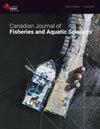劳伦森五大湖微塑料污染的管理策略——监测(上)
IF 2.2
2区 农林科学
Q2 FISHERIES
Canadian Journal of Fisheries and Aquatic Sciences
Pub Date : 2023-07-10
DOI:10.1139/cjfas-2023-0022
引用次数: 0
摘要
加拿大渔业和水生科学杂志,即将出版。塑料污染蔓延到包括野生动物在内的所有五大湖生态系统,根据实验室实验和风险评估,存在潜在风险。由于污染范围广泛,并根据证据表明存在可衡量的风险,现在是决策者制定和实施监测计划以指导管理的时候了。在这里,我们将讨论具有明确指导方针的监测策略的必要性。我们综合了在五大湖发表的研究,报告了污染,研究重点地区,以及跨矩阵使用的方法。根据我们的发现,我们建议研究如何为指导方针和下一步提供信息——特别是如果微塑料被认为是五大湖水质协议下的有毒化学子指标。今后的监测应使用标准和(或)统一的采样和分析规程,在整个流域建立基线,并开始跟踪污染的变化情况,以评估五大湖的健康状况,为减少污染源提供信息,并衡量旨在减少向淡水排放塑料的政策的有效性。本文章由计算机程序翻译,如有差异,请以英文原文为准。
Towards a management strategy for microplastic pollution in the Laurentian Great Lakes—monitoring (part 1)
Canadian Journal of Fisheries and Aquatic Sciences, Ahead of Print.
Plastic contamination extends across all Great Lakes ecosystems, including in wildlife, with the potential for risk based on laboratory experiments and risk assessment. Due to widespread contamination, and based on evidence suggesting measurable risk, it is time for policy-makers to develop and implement monitoring programs to guide management. Here, we discuss the need for a monitoring strategy with clear guidelines. We synthesize the research that has been published across the Great Lakes, reporting on contamination, regions that have been the focus of study, and the methods used across matrices. Based on our findings, we suggest how research may inform guidelines and next steps—especially if microplastics are to be considered as a toxic chemical sub-indicator under the Great Lakes Water Quality Agreement. Future monitoring, using standard and (or) harmonized protocols for sampling and analysis, should build baselines across the basin and begin tracking how contamination changes to assess the health of the Great Lakes, to inform source reduction, and to measure the effectiveness of policies aimed at reducing emissions of plastics to freshwater.
Plastic contamination extends across all Great Lakes ecosystems, including in wildlife, with the potential for risk based on laboratory experiments and risk assessment. Due to widespread contamination, and based on evidence suggesting measurable risk, it is time for policy-makers to develop and implement monitoring programs to guide management. Here, we discuss the need for a monitoring strategy with clear guidelines. We synthesize the research that has been published across the Great Lakes, reporting on contamination, regions that have been the focus of study, and the methods used across matrices. Based on our findings, we suggest how research may inform guidelines and next steps—especially if microplastics are to be considered as a toxic chemical sub-indicator under the Great Lakes Water Quality Agreement. Future monitoring, using standard and (or) harmonized protocols for sampling and analysis, should build baselines across the basin and begin tracking how contamination changes to assess the health of the Great Lakes, to inform source reduction, and to measure the effectiveness of policies aimed at reducing emissions of plastics to freshwater.
求助全文
通过发布文献求助,成功后即可免费获取论文全文。
去求助
来源期刊

Canadian Journal of Fisheries and Aquatic Sciences
农林科学-海洋与淡水生物学
CiteScore
4.60
自引率
12.50%
发文量
148
审稿时长
6-16 weeks
期刊介绍:
The Canadian Journal of Fisheries and Aquatic Sciences is the primary publishing vehicle for the multidisciplinary field of aquatic sciences. It publishes perspectives (syntheses, critiques, and re-evaluations), discussions (comments and replies), articles, and rapid communications, relating to current research on -omics, cells, organisms, populations, ecosystems, or processes that affect aquatic systems. The journal seeks to amplify, modify, question, or redirect accumulated knowledge in the field of fisheries and aquatic science.
 求助内容:
求助内容: 应助结果提醒方式:
应助结果提醒方式:


